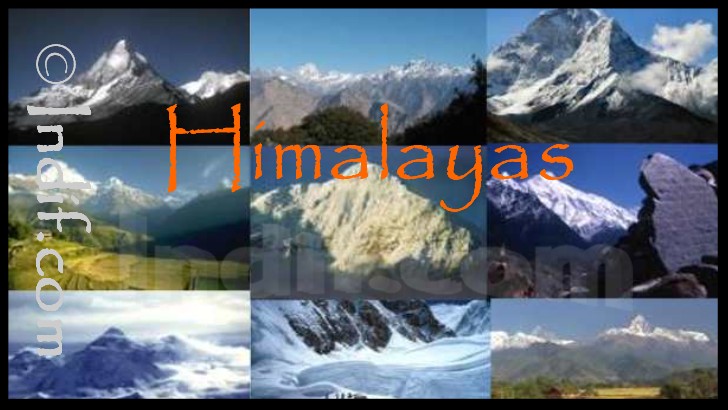Himalayas in Sanskrit means ‘abode of snow,' which was coined by joining two Sanskrit words — ‘hima’ (snow) and ‘alaya’ (abode).
Some of the highest mountains in the world are located in northern India. These are part of the Himalaya mountains. Being the world's highest mountain chain, the Himalayas is characterized by its great height, complex geologic structure, snowcapped peaks, large valley glaciers, deep river gorges, and rich vegetation. They were given the name Himalaya which means "home of snow", because snow never melts on their high peaks.
The Himalayas form the planet's highest mountain region, containing 9 of the 10 highest peaks in the world. Among these peaks are the world's highest mountain, Mount Everest (8848 m), which is on the Nepal-Tibet border; the second highest peak, K2 or Mount Godwin Austen (8,611 m), located on the border between China and Jammu and Kashmir, the third highest peak, Kanchanjunga (8,598 m) on the Nepal-India border.
The mountains also act as a climate barrier. They
mark the transition from the humid, sub-tropical weather
systems of India's plains and hills to the dry, arid
desert climates of central Asia. They help contain
India's weather and are instrumental in making it what
it is. For instance, the northbound monsoon rains are
forced to lose most of their moisture on the Indian side
of the range, thereby leaving the northern Tibetian side
relatively dry. The Himalayas themselves, despite their
peaks being blanketed in snow, have a temperate Alpine
climate and a lot of lush vegetation.
The Himalayas can be classified in a variety of ways. From south to north, the mountains can be grouped into four parallel, longitudinal mountain belts.
Shivaliks (Outer Himalayas or Sub-Himalayas)
Himachal ( Lower Himalayas)
Himadri ( Higher
Himalayas)
Trans-Himalayas (Tibetan Himalayas)
From west to east the Himalayas are divided broadly into three mountainous regions - the Western Himalayas, the Central Himalayas and the Eastern Himalayas.
Major Himalayan Hill Stations include Gulmarg, Sonamarg, Dharamsala, Ladakh, Simla, Nainital, Kullu, Manali, Dalhousie, Mussoorie, Rishikesh, Amarnath, Gangtok, Kailas Mansarovar, Vaishno Devi, Patni Top etc. :
The Himalayas is the world's highest mountain range comprising all top ten of the world's highest peaks. In fact, the Himalayas includes 14 peaks more than 8,000 meters high and some 200 more than 6000 meters.
Interesting Facts about Himalayas
- Himalayan mountain range is one of the youngest mountain range in the world. It is located in the northern border of India and separates Indian subcontinent from other countries of Asia.
- Himalaya affects climate of Asia greatly. It is the reason for the heavy rainfall in Terai region. It has a great role behind the creation of Gobi desert.
- Himalayan mountain range is the part of five countries-Bhutan, Nepal, Pakistan, India and China.
- Himalayan mountain range is the home of the Ganges,Yamuna, Brahmaputra,and Indus rivers.
- Himalayan mountain range is the home of the Mount Everest,Karakoram, and Kanchenjunga peaks.
- Mount Everest at 29,029 ft (8,848 m) is not only the highest peak in the Himalayas, but the highest peak on the entire planet.
- Mt. Everest was named after Colonel Sir George Everest, a British surveyor who was based in India during the early-to-mid-nineteenth century.
- The Himalayas are an extremely cultural and spiritual place; many of the peaks have significance in Hindu, Sikh and Buddhist cultures.
- According to the Hindu mythology, Himalayas is the home of God Shiva.
- A lot of medicinal herbs can be found at the foothills of Himalayas. They are considered the purest of all.
- In 29 May 1953, Edmund Hillary and Tenzing Norgay became the first human beings to climb Mount Everest, world’s highest peak, located in Himalayas. Tenzing buried his daughter’s red and blue pencils on the top of Mount Everest.
- The Himalayas cover approximately 75% of Nepal.
- Nepalese call Himalayas ‘Samgarmatha’ that means ‘Goddess of the Universe’ or ‘Forehead of the Sky.'
- Himalaya is the source of major rivers of Nepal.
Pure heart is compared to the Himalayas, to the ocean of Milk, to a chariot for the Divine."
- Sri Sathya Sai Baba, an Indian Spiritual leaderNobody climbs mountains for scientific reasons. Science is used to raise money for the expeditions, but you really climb for the hell of it.
- Sir Edmund Hillary.









